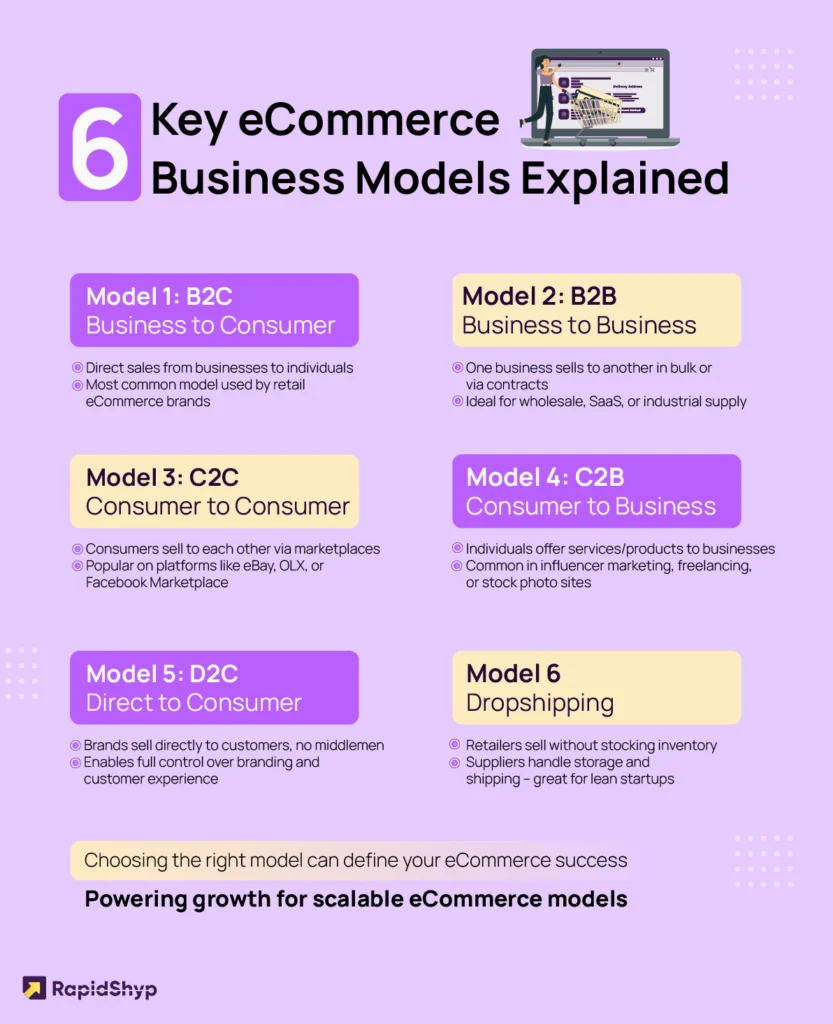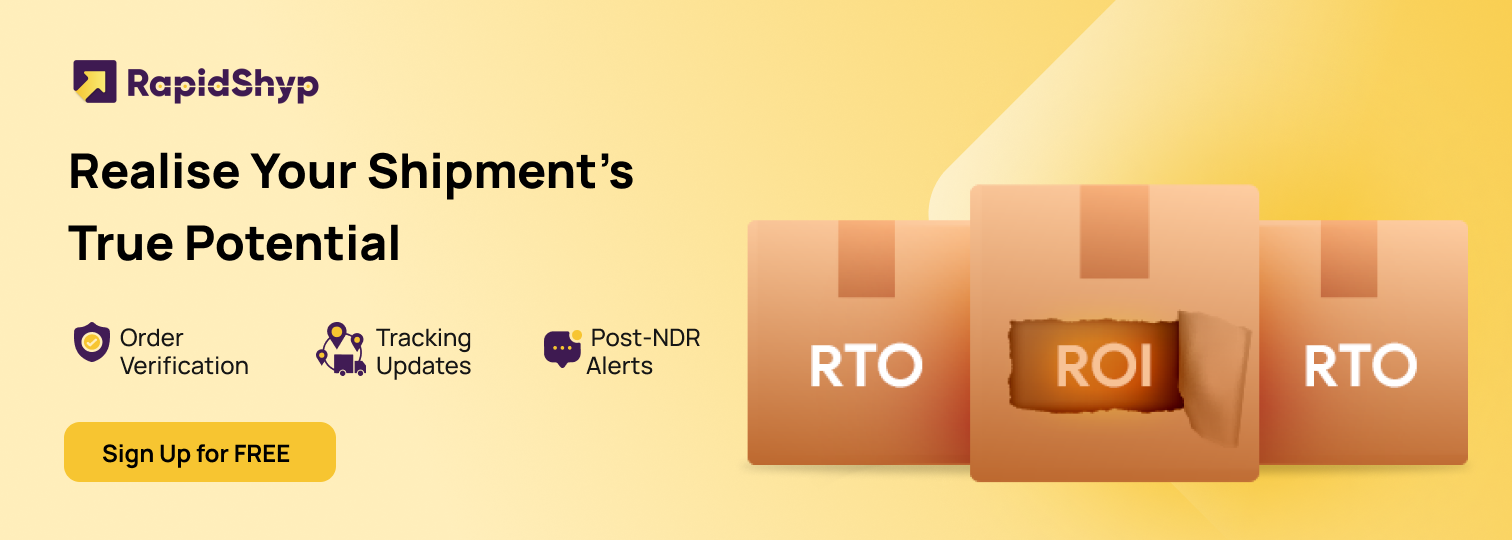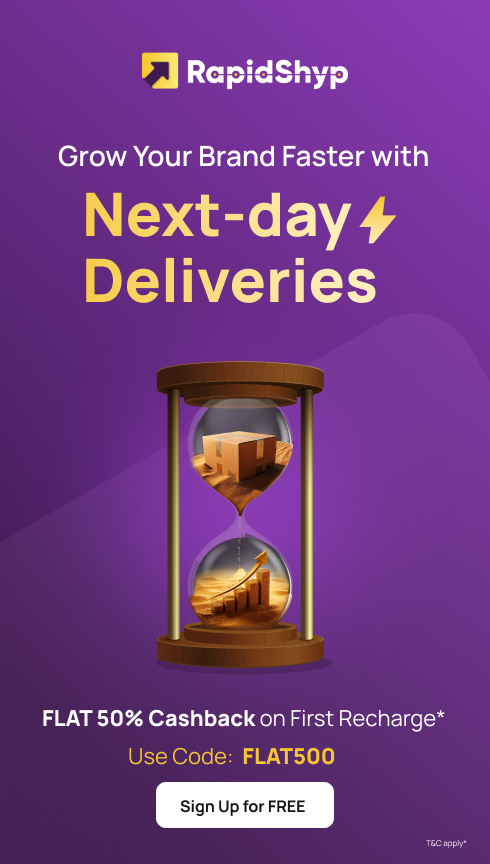Table of Contents
Are you wondering how to start an eCommerce business? You’ve probably got a product in mind, maybe even a name picked out for your brand, and dreams of becoming the next big thing in your niche. But before you dive into designing that fancy logo or setting up your store, one crucial question could make-or-break your business.
Which eCommerce business model should you choose?
Spoiler alert: There’s no one-size-fits-all answer.
But the good news?
Once you understand the key types of eCommerce models and how they function in today’s digital marketplace, you’ll be in a prime position to make the right decision- one that aligns with your product, market, and long-term goals.
What is a Business Model?
Think of your business model as the blueprint for how your online business will make money while delivering value. It’s your how, not just your what.
Your model answers:
Who are you selling to?
How are you delivering your product or service?
What are you charging (and why)?
How do you stay profitable while scaling?
Before you add a “Buy Now” button to your site, you need clarity on the structure that supports it.

Different Kinds of eCommerce Business Models You Need to Know in 2025
Business to Consumer (B2C) — The Classic Model
If you’ve ever bought a product from Amazon or Target online, congrats- you’ve engaged in B2C eCommerce.
In this model, businesses sell directly to everyday consumers. It’s fast, familiar, and most common.
Example: A customer buys sneakers directly from an online store.
Big Player: Amazon sells everything from groceries to gadgets online.
Pros: Simpler setup, broad market, faster sales cycle
Watch out: Heavy competition, customer expectations are sky-high
Business to Business (B2B) — Where the Big Deals Happen
This model is all about selling products or services from one business to another. Think wholesale purchases, software solutions, or specialised services.
Example: A print-on-demand company buys blank t-shirts in bulk from a manufacturer.
Big Player: Alibaba, your B2B marketplace king.
Pros: Bigger order volumes, long-term contracts
Watch out: Longer sales cycle, requires relationship-building
Consumer to Consumer (C2C) — The Digital Flea Market
Have you ever sold your old iPhone or that jacket you never wore on Facebook Marketplace or eBay? That’s C2C in action.
Example: Someone sells a second-hand PlayStation to another person via an online marketplace.
Big Player: OLX thriving in the peer-to-peer resale world.
Pros: Low startup costs, easy access via platforms
Watch out: Trust and fraud concerns, less control over the experience
Consumer to Business (C2B) — Freelancers, This One’s for You
In C2B, the power flips- consumers offer value to businesses.
Think graphic designers, freelance writers, influencers offering sponsored posts.
Example: A logo designer sells custom branding services to a startup.
Big Player: Freelancer.com and Upwork
Pros: Flexible, creative work with multiple clients
Watch out: Feast-or-famine income cycles, project-based burnout
Direct to Consumer (D2C) — The Brand-Building Powerhouse
This model is red-hot in 2025. Brands are ditching the middlemen and selling directly to you.
Example: Lenskart sells eyewear directly through its website.
Big Players: Bewakoof, Boat, HealthKart
Pros: Full control over brand and experience
Watch out: Demands a strong marketing and fulfilment strategy
Dropshipping — The Low-Risk Launchpad
Want to run an online store without ever touching the inventory? Welcome to dropshipping.
In this model, you sell products on your site, but a third-party supplier handles storage, packing, and shipping. You’re the middleman with the marketing skills.
Example: A store sells trendy phone cases but orders are fulfilled and shipped by a supplier in China.
Big Player: Meesho and Shopify stores powered by apps like Oberlo or Spocket.
Pros: Minimal upfront investment, no need to manage stock
Watch out: Thin profit margins, limited control over product quality and delivery speed
Only knowing about different kinds of eCommerce models won’t help. What’s the next big thing?
Read More: How to Start an eCommerce Business in 2025
How to Choose the Right eCommerce Model (Without Guesswork)
Here’s where theory meets action. Ask yourself the following before locking in a model:
Who Are You Selling To?
B2C or D2C works for individual shoppers.
B2B is your go-to if you’re targeting companies.
C2C? Perfect if you’re creating a marketplace.
Pro Tip: Build a customer persona. Know their age, habits, pain points. It’ll guide your direction like a GPS.
What Are You Selling?
- T-shirts? Probably B2C or D2C
- Custom software? Lean into B2B
- Freelance services? You’re in C2B territory
Make a list of your offerings and match them with the model that best delivers them.
What’s the Competition Up To?
Peek at competitors’ websites. What are they doing well? Where are they falling short? Their models may hint at untapped niches—or oversaturated markets you’ll want to avoid.
Can You Afford It?
Some models are more expensive to operate than others. D2C might offer high margins, but also demands investment in branding, fulfillment, and customer service.
Create a cost breakdown:
- Tech tools
- Marketing spend
- Shipping fees
- Transaction costs
This gives you a realistic picture of profitability.
Got the Right Tech Stack?
Your model might need a simple Shopify store or a fully customised backend for bulk B2B orders. Don’t commit to a model you can’t support technically.
Plan your tools now, not later.
Think Specialised. Think Smarter.
Running internal ordering systems, employee reward shops, or bulk-branded merchandise programs? An Online Company Store might be your best-kept secret weapon. These specialised eCommerce solutions are tailored to help organisations streamline internal operations while delivering a top-notch user experience.
Customer Experience = Everything in 2025
It’s not just about what you sell- it’s also about how you sell it.
Are you building a quick-click convenience store, or a hyper-personalised brand that builds loyalty over time? Align your model with the experience you want customers to have.
Planning to sell PAN India? You must understand eCommerce regulations, taxes, and data policies. One slip and you could be in for a compliance nightmare. Consult an expert if needed.
Make It Fit Your Marketing Strategy.
If your marketing is TikTok-heavy and social-first, a D2C model might make more sense than B2B. Know your channels, budget, and skill set – and ensure your business model fits like a glove.
The Bottom Line: Your Future Starts with the Right Foundation
The truth is, every successful online business in 2025 began by answering one question:
“What model works for what I want to build?”
Now that you know the options—and how to evaluate them—you’re already ahead of 90% of new founders out there.
So go ahead, choose your model with confidence. And remember: this isn’t a decision you lock in forever. The best entrepreneurs adapt, evolve, and pivot when needed.
Ready to build your eCommerce empire? Start with the model, and opt for Dispatch, a one-stop solution for shipping! The money will follow.
Calculate Your Shipping Rates

| Courier Partner | Mode | Chargeable Weight (KG) | Shipping Rates |
|---|



